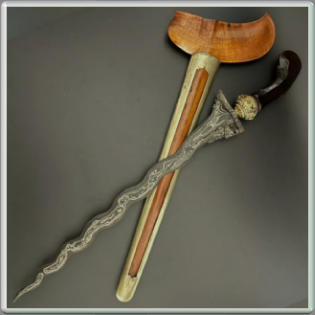
© BuySellTrade.onle All Rights Reserved 2024 USA
All Payments Are Secure
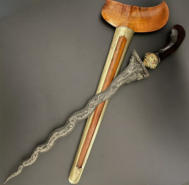

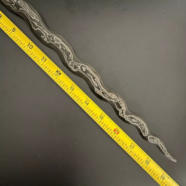






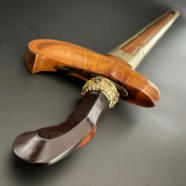

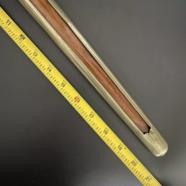
Antique Beautiful Gemstone Indonesia
Kris Keris Meteoric Blade Dagger & Sheath.
History of these beautiful Kris Keris Dagger’s: The oldest known iron dagger in the world was the one found wrapped up with Pharaoh Tutankhamun’s mummy in 1925, three years after his nearly intact tomb was opened. For several decades, scientists were flummoxed by the blade because at the time iron smelting was not thought to have become fully developed until two or three centuries after the young pharaoh’s death. They assumed that it was meteoritic iron not smelted from ore but forged into shape with hammer and anvil. When X-ray fluorescence spectroscopy was used in 2016 to confirm for certain that blade was made with meteoritic iron, there was a surprise. The iron came from more than one meteorite. This implied “significant mastery of ironworking in Tutankhamun’s time,” according to the results published in famous scientific journals. The most beautiful blades were forged on the island of Java since the year 800 CE., when bladesmiths crafting royal krisses created the inlaid patterns known as pamor (meaning aura) using nickel iron ores from a large meteorite that had fallen near the Prambanan Temple complex near Borobudur. Keris have a long history, with some evidence that the first of these blades made their appearance around 800 CE. The types known today emerged in the 1300s. Most have sinuous blades, the waves, called luk, meant to imitate a serpent—naga—in motion.
Although they’ve always had ceremonial uses, and many were and are quite
delicate, not so long ago some keris were actual weapons, particularly those forged
in Bali, which were effectively short swords. Today, they are almost exclusively
ceremonial, magical guardians and talismans of households, protective heirlooms
passed along generation to generation, some simple and even crude, some
breathtakingly beautiful, artistic masterpieces.
You’ll see scores of keris stuck through sarong sashes at the small of the back or
sometimes over a shoulder by people attending weddings and funerals and other
ritual events that happen frequently on the islands. Security guards at many public
events wear them as a symbol of authority. Mostly, it's men who carry them. But at a
typical event of a few hundred people, you may also see a dozen or so women with
a keris tucked into a sash.
The best of these blades are gorgeous creations, each with a pattern called a
pamor. Hundreds of such patterns exist. They traditionally are designed to match the
individual’s personality and other factors. This includes the number of waves in the
blade, which is always an odd number and never more than 13. On the best keris,
hilts and exotic wood sheaths are decorated with semi-precious stones, gold and
intricate carvings.
I have many of these authentic rare daggers that value over $100,000 USD shown in
famous books dating back 30+ years.
$1998.00 USD




Updating Products Daily

© BuySellTrade.onle All Rights Reserved 2024 USA
All Payments Are Secure
Antique Beautiful Gemstone Indonesia Kris Keris
Meteoric Blade Dagger & Sheath.
History of these beautiful Kris Keris Dagger’s:
The oldest known iron dagger in the world was the one found wrapped up with
Pharaoh Tutankhamun’s mummy in 1925, three years after his nearly intact tomb
was opened. For several decades, scientists were flummoxed by the blade because
at the time iron smelting was not thought to have become fully developed until two or
three centuries after the young pharaoh’s death.
They assumed that it was meteoritic iron not smelted from ore but forged into shape
with hammer and anvil. When X-ray fluorescence spectroscopy was used in 2016 to
confirm for certain that blade was made with meteoritic iron, there was a surprise.
The iron came from more than one meteorite. This implied “significant mastery of
ironworking in Tutankhamun’s time,” according to the results published in famous
scientific journals.
The most beautiful blades were forged on the island of Java since the year 800 CE.,
when bladesmiths crafting royal krisses created the inlaid patterns known as pamor
(meaning aura) using nickel iron ores from a large meteorite that had fallen near the
Prambanan Temple complex near Borobudur.
Keris have a long history, with some evidence that the first of these blades made
their appearance around 800 CE. The types known today emerged in the 1300s.
Most have sinuous blades, the waves, called luk, meant to imitate a
serpent—naga—in motion.
Although they’ve always had ceremonial uses, and many were and are quite
delicate, not so long ago some keris were actual weapons, particularly those forged
in Bali, which were effectively short swords. Today, they are almost exclusively
ceremonial, magical guardians and talismans of households, protective heirlooms
passed along generation to generation, some simple and even crude, some
breathtakingly beautiful, artistic masterpieces.
You’ll see scores of keris stuck through sarong sashes at the small of the back or
sometimes over a shoulder by people attending weddings and funerals and other
ritual events that happen frequently on the islands. Security guards at many public
events wear them as a symbol of authority. Mostly, it's men who carry them. But at a
typical event of a few hundred people, you may also see a dozen or so women with
a keris tucked into a sash.
The best of these blades are gorgeous creations, each with a pattern called a
pamor. Hundreds of such patterns exist. They traditionally are designed to match the
individual’s personality and other factors. This includes the number of waves in the
blade, which is always an odd number and never more than 13. On the best keris,
hilts and exotic wood sheaths are decorated with semi-precious stones, gold and
intricate carvings.
I have many of these authentic rare daggers that value over $100,000 USD shown in
famous books dating back 30+ years.

$1998.00 USD
